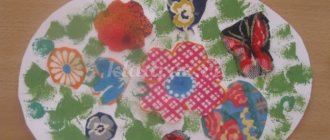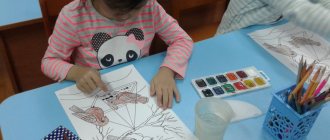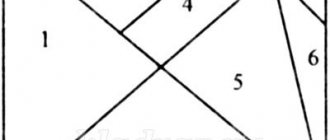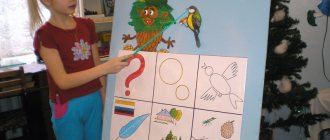How to organize a duty schedule?
Whatman paper can serve as the basis for organizing duty in kindergarten, creating a schedule and schedule. It is best to place photographs of the students on the sheet or assign each child his own symbol. This notation will be useful later. The line of duty can be arranged in alphabetical order of the children's surnames, if desired, or according to the principle of desks, the children at the first table are on duty first, and at the end of the month - the children at the last.
For good behavior, help and attentiveness, the child will receive a card at the end of duty. If, for example, the paper is red, it means that the child coped with his duties perfectly. If something didn’t work out during duty, the card may be a different color.
On whatman paper with your own kindergarten duty schedule, you can add small pockets under the photographs of the pupils, in which leaflets indicating the child’s achievements will be stored. Or you can do without photographs of children and put images of special symbols that would characterize the pupil directly into a special handbag.
For example, the duty officer chose a squirrel as his own symbol, and for successfully completed work, red cards with the image of a squirrel will appear in his pocket. This will mean that this particular student copes well with all tasks.
Thus, being on duty develops another trait in children - the ability to fantasize. After all, when creating a duty corner in a kindergarten with their own hands, students will be able to fully demonstrate their creative abilities, as well as when choosing a personal picture that will become a symbol of successful work.
Organization of duty for preschool children in preschool educational institutions
Valentina Amelchenko
Organization of duty for preschool children in preschool educational institutions
Organization of children's duty
preschool age in preschool educational institution
Duty duty is one of the forms of organizing children’s work , which requires the child to perform work aimed at serving the team. Duty involves the work of one or more children in the interests of the entire group. Despite the seemingly insignificant result of labor, duty is of great importance in raising children . On duty, to a greater extent than on assignment, the social orientation of work, the real, practical care of several children for others , is highlighted, therefore this form contributes to the development of responsibility, a humane and caring attitude towards people and nature. Duty duties place the child under conditions of obligatory fulfillment of certain tasks necessary for the team. This allows children responsibility towards the team, caring, and an understanding of the necessity of their work for everyone.
An important task of organizing duty in preschool age is to develop in children responsibility for the assigned work, the desire to work for the benefit of the team, and the habit of systematically performing duties. be cultivated in children only through their regular participation in work. The duty of preschoolers is gradually becoming more complex in terms of the content of work, the forms of association, and the requirement for independence and self-organization in work . It is very important for the teacher to think through the content of the work of the attendants so that it is not formal, but specific. He addresses those on duty as his assistants, approves of their actions, diligence, initiative, ability to complete tasks, and use rational techniques.
Thus, according to the content of labor, duty is divided into
- duty in the dining room;
-preparation for classes;
- duty in a corner of nature.
Second junior group Duties in kindergarten are organized from the second junior group - the second half of the year. Kids are involved in preparing the feeding process and carry out the simplest instructions: placing chairs correctly on the tables, plates with bread, glasses with napkins in the middle.
By giving instructions to children of the 4th year of life, the teacher develops in them the ability to perform several labor actions related to setting the table. children are first taught to place napkin holders and bread bins on the table, then to lay out spoons. After the baby masters these actions, he is taught to arrange the plates.
At the initial stages of instilling duty , techniques such as setting tables with the child are used, later with a little help from the teacher, as well as didactic games: “Let’s set the table for dolls”
,
“Mishka’s Birthday”
,
“Masha Is Having Lunch”
,
"Feeding the dolls"
and etc.
In the first months, it is necessary to teach those on duty the correct work techniques: remind them that cups should be taken by the handle, the bread bin should be carried with both hands, etc.
The child on duty is given only one condition: to help the assistant teacher set the tables. an attendant at each table . After washing his hands with soap, putting on an apron and cap (kerchief), the child helps distribute spoons, places bread bins, glasses with napkins, prepared in advance by adults on the distribution table. When guiding children, the teacher relies on interest in the process of activity, creates an emotionally positive attitude towards it. The teacher teaches the child to maintain consistency in work and the ability not to be distracted from the task, and also strives to create a calm environment, controls him, and comes to his aid, taking into account his individual capabilities.
Middle group
In the middle group, children continue to be on duty in the dining room attendants are appointed , who completely set the tables: hand out individual napkins, spoons, forks, place bread bins, glasses with napkins, prepared in advance on the serving table. The attendants themselves fill the glasses with napkins.
In the second half of the year, in the middle group, duty for classes (lay out brushes, put jars of paste, lay out individual napkins, etc., they also help clean up the material after classes.
The teacher emphasizes how much the child cares about his friends, is attentive to them, and how he treats his responsibilities. He explains that the work of duty officers is necessary , that children should help adults in their work, and is based on positive examples of children’s behavior at work .
Senior group
The older group is also assigned two children each serve The attendants come in early (quickly change clothes, wash their hands, put on aprons, scarves or caps and fully set the table with dishes prepared in advance by the assistant teacher at the serving table, in accordance with the number of children . The process must be supervised by an adult.
In part, children clean up after themselves. After eating, each child moves his plate to the edge of the table and takes the cup to the serving table as in the middle group. At the same time, it is important to ensure that children do not linger near the serving table and create chaos.
the attendants should remove napkin holders and bread bins, help put away spoons and forks, and sweep crumbs off the tables.
The children thank the officers on duty for the help they provided . The teacher checks the performance of their work by those on duty the children in it . The requirements for the pace of work, the manifestation of organization in its process , efficiency and independence are increasing.
The work of the attendants should be combined with the self-service of children . The attendants themselves or with the help of the teacher decide who will do what.
The teacher addresses them as his assistants, teaches them to perform the task deftly, using economical techniques, encourages the inept, and approves of initiative and diligence.
Duties in preparation for classes. Help can be provided both before class and the day before. Before the lesson, those on duty should find out what materials will be needed, help distribute the necessary material, pour glue, and bring materials for the lesson to the group. The day before class, help cut out geometric shapes, bring visual material, help wipe off dust, and arrange chairs.
If the teacher knows how to rely on the help of those on duty , and emphasizes its importance in every possible way, the children responsibility for completing the assigned task increases.
Also, in the senior group, another type of duty is being introduced - duty in a corner of nature . (starts from the beginning of the year)
.
The meaning of this type of duty can be explained in class when getting acquainted with plants and their needs, as well as with the conditions for keeping these plants. The teacher emphasizes the importance of careful constant care of plants; Only under this condition will they feel good in the group. During the lesson, the teacher can also show some new techniques for the work of those on duty : how to spray plants from a spray bottle (which ones need to be sprayed and which ones shouldn’t, why, how to plant onions instead of cut ones, how to prepare water for watering plants, etc.
When the teacher moves on to organizing the general work of the attendants , he unites children in pairs . Often, educators unite children in pairs according to the principle of “skilled with incompetent”
.
But this does not always give a positive result. In older groups, children show a selective attitude towards each other and this should be taken into account when assigning them to be on duty together .
It is very important for the teacher to think through the content of the work of the attendants , so that it is not of a formal nature, but is specific and necessary for the team. The teacher addresses those on duty as his assistants, approves of their actions, diligence, initiative, ability to complete tasks, and use rational techniques. So before class, the teacher, addressing the children, says: “ The attendants prepared everything they needed so quickly that you can start studying right away. Thank you, well done!” Another time he may turn to them with the question: “Well, can we start the lesson? Invite children to a lesson ."
All this increases children's interest in the matter . They feel that their work is needed, and the teacher’s encouragement of their actions strengthens their confidence in their abilities.
The teacher also teaches children to thank those on duty for the service provided and to respect their work. If the teacher knows how to rely on the help of those on duty , and emphasizes their importance in every possible way, the children responsibility for completing the assigned task increases. This is also facilitated by conversations on the topic “How we are on duty ”
.
From time to time, the teacher emphasizes the children's , discusses with them what else they can do; in the conversation, he especially highlights cases of manifestation of a friendly attitude towards peers, a desire to help the assistant teacher. It is very important that the assistant teacher rely in her work on the help of children , and be patient with their uncertain movements and slow pace of activity. It can be of great assistance to the teacher in teaching children the necessary skills .
Clothing and equipment necessary for children on duty and work
In order for children to be on duty in the dining room , in a corner of nature, to prepare materials and aids for classes, a variety of equipment is needed.
For the dining room: aprons and scarves (for boys - caps or bandanas.
In a corner of nature: oilcloth aprons, sleeves.
All equipment is kept within the access of children in accordance with their growth.
DINING DUTY IN JUNIOR GROUPS
· Duties are of great importance in raising children:
. Those on duty always perform work that has social significance and is necessary for the team. Forms a desire to work for the sake of others, to show a caring attitude towards one’s comrades, to develop the ability to help an adult, to notice where help is needed.
· Being on duty in the canteen develops in children moral and volitional qualities and skills, the ability to accept a goal and achieve results.
· From the age of 2, children are involved in the preparation of the feeding process, carry out simple tasks: place chairs correctly at the table, place plates with bread in the middle of the tables, place spoons on the right side of the plates standing on the table.
· Dining room duty is carried out from the 2nd junior group.
· Tasks: help the assistant teacher set the table at which he and his friends are sitting. Distribute spoons, put out bread bins, vases with napkins.
· Before introducing duty, the teacher organizes special classes in which he shows and explains in detail all the actions, involving children in their implementation.
· While on duty, the teacher explains the need to work hard and encourages any attempt by the child to show independence.
· Reminds you of the order of priority in completing assigned tasks:
“Today Ira will take care of his comrades and will be on duty at his desk. Dima will set this table... Let them work for everyone today, and let other children do it tomorrow.”
· The teacher teaches children to carry out the assigned task without being distracted, without fussing, without rushing, without finishing one task, not to move on to another.
The teacher says in a friendly tone: “Kolya, don’t rush. Why are you in such a hurry? You will have time to do everything. Lay out the spoons carefully for all the children.”
Supervising the work of those on duty, the teacher reinforces the skills of laying out cutlery: “Spoons should be taken by the handle, one at a time, placed on the right side of the plate.” If forks are given, then the fork lies closer to the plate with its sharp ends up, and then the spoon with its convex side down. Now put the bread basket in the very middle of the table so that it’s easy for everyone to reach, and then put the napkins. First you need to finish one thing, and then start another.”
· “Let's see how you arranged the spoons. Did you miss anyone?
· The teacher supports indecisive children, encourages:
“I know, Nadyusha, you will set the table well now. Start handing out spoons: to Katya, and Sasha, and your friend Anya.”
· You should not constantly set the same children as an example and assign them to duty. Slightly higher demands can be placed on them.
· As children master skills, the teacher’s role in supervising those on duty changes. Initially, he reminds the kids of work techniques, the sequence of operations, and helps them cope with the task.
· Later, the adult limits himself to advice, general reminders, control, and approval.
· It is important that the duties of duty officers are performed by all pupils, and not just active and skillful ones.
Card file of work assignments in the senior group card file on the topic
File of work assignments in the senior group
"Putting toys back in place"
Goal: to improve the ability to independently maintain order in a group (cleaning up building materials, toys). To cultivate aesthetic taste and the desire to work for the benefit of others.
"Order in the toy closet"
Goal: to teach children to independently and aesthetically arrange toys, maintain order in closets, and wipe dust. Develop hard work and the ability to see disorder. To cultivate aesthetic taste and the desire to work for the benefit of others.
"Helping the nanny"
Goal: To teach how to clear dishes from tables after meals, to teach children to provide all possible assistance to adults. Develop hard work and a desire to help adults. Foster respect for the work of adults.
"Dining duty"
Goal: independently and conscientiously perform the duties of a duty officer; wash your hands thoroughly, put on the clothes of the person on duty, set the table correctly, put away the dishes after eating. Develop labor skills and abilities, the ability to see disorder in the table setting. Cultivate a desire to work for the benefit of others.
"Class Duty"
Goal: independently and conscientiously perform the duties of an attendant: lay out materials and aids prepared by the teacher for the lesson on tables; wash and put them away after class. Develop hard work and a desire to help adults. Cultivate a desire to work for the benefit of others.
"Order in toys"
Goal: to teach children to put on work aprons before starting work; keep toys in order: wash, dry, wipe and put in place. Develop hard work and the ability to see disorder; be careful when working with water. Cultivate a desire to work for the benefit of others.
"Duty in a corner of nature"
Goal: to improve the ability to independently care for indoor plants: watering, loosening the soil. Foster a sense of responsibility. Learn to follow safety and personal hygiene rules.
"Clean flower pallets"
Goal: to teach children to observe hygienic skills when working with water: roll up their sleeves, wet a cloth and wring it dry, rinse when dirty. Develop labor skills and habits, accuracy when working with water. Cultivate a desire to work. Learn to follow safety and personal hygiene rules.
"We wash napkins"
Goal: teach children the skills of soaping, rinsing and wringing out napkins, and continue to build a work culture. Develop hard work and the ability to see disorder; be careful when working with water. Cultivate a desire to work in a team, in harmony.
“Order in the dressing room closet” (together with the teacher’s assistant)
Goal: to teach children to maintain order in their personal wardrobes: empty the closet of clothes and shoes, wipe the shelves with a damp cloth, and neatly put the clothes back in place. Develop diligence, the ability to see disorder, and accuracy when working with water. Cultivate a desire to work in a team, in harmony.
"Book Repair"
Goal: to teach children to peck at books, use glue and scissors correctly, and use napkins. Develop labor skills, eye, fine motor skills, creative imagination. Foster a desire to work for the benefit of others, treat books and toys with care.
"Clean chairs"
Goal: to teach children to keep the chairs in the group room tidy and clean: wipe them with a damp cloth; arrange in places after classes. Develop labor skills and abilities, the ability to comply with cultural and hygienic requirements when working. Cultivate a desire to help adults and respect for their work.
"Washing Doll Clothes"
Purpose: To teach children to help the teacher in washing doll clothes and bedding: to teach children to put on work aprons before starting work; prepare the necessary supplies for washing and drying, as well as a workplace; know how to use soap. Develop labor skills and abilities, the ability to comply with cultural and hygienic requirements when working. Cultivate a desire to work for the benefit of others.
"Washing the Dolls"
Goal: To teach children to help the teacher in washing dolls: rinse soaked dolls, clean them with brushes. Develop diligence, the ability to see disorder, and accuracy when working with water. Cultivate a desire to help adults and respect for their work.
“The closet is in order” us in
Purpose: To teach children to be careful when folding things in a coat closet.
“Changing the towels.”
Goal: To develop a desire to work, to be able to offer help.
“Helping the nanny put bedding on the beds.”
Goal: To teach how to sort bed linen according to their belongings, to cultivate a desire to help the nanny and respect for other people’s work. Cultivate a desire to work, a sense of responsibility for the assigned work.
“Let’s arrange the chairs in a certain order.”
Goal: Continue to develop work skills; carry out the assignment carefully, quickly, diligently.
"Cleaning up building material"
Goal: To teach how to wash, dry and lay building materials, to teach children to constantly and promptly maintain order in the play corner, to wash building materials with a soapy solution prepared by the teacher, to rinse it, and to dry it; observe the rules of personal hygiene.
Features of organizing duty in the second junior and middle group of preschool educational institutions
The organization of duty begins with the second junior group in the second half of the school year. Children begin to be involved in helping prepare for breakfast, lunch or dinner, by being assigned to perform simple actions, for example, correctly placing chairs near the table, napkin holders and bread bins on the table, etc.
Before involving children on duty, the teacher has conversations with them, in which they talk about how to prepare for duty (wash hands, put on aprons and headscarves, etc.). At first, the teacher reminds the children of the sequence of preparation and helps them get ready. This is done until the children master the sequence of actions and perform them independently.
At the first stages of organizing duty in the second junior group, the teacher and assistant teacher use the following techniques:
- setting the table together with the child;
- conducting thematic didactic games (“Mishka’s Birthday”, “Dolls Drink Tea”, etc.);
- conducting conversations, discussions, etc.
Note 2
Thus, in the second junior group, at the first stages of organizing duties, children are given the task of providing all possible assistance to the junior teacher in setting the table. The task of the teacher and junior teacher is to establish friendly interaction, create a positive emotional and psychological attitude towards work during duty.
In the middle group, children continue to help in the dining room. The difference is that a couple is assigned to be on duty, who completely sets the tables (arranges dishes, lays out napkins, etc.) and helps the junior teacher clear the tables.
In the second half of the year, class duties are introduced in the middle group. While on duty, children independently prepare tables for study sessions (lay out brushes, place jars of paste, place individual napkins, etc.). At the end of the lesson, the children help the teacher clear the tables.
The teacher’s task is to show the child the significance of his work and maintain positive motivation for being on duty. The teacher teaches children to work in pairs, organize their work, share responsibilities, and help each other. Each time, while on duty, the teacher reminds the children the importance of their work not only for the entire group, but also for the teacher himself and the junior teacher whom they provide assistance.
Note 3
Thus, in the middle group, the content and form of work during duty become more complex. The responsibilities of the duty officer are expanding.
Article “Organization of duty in the middle group and their influence on the education of preschool children”
Author: Tatiana Yuryevna Lovchikova, teacher of the MKDOU “Central Regional Resource Education Center No. 5 “Dolphin”, Semiluki.
Article "Organization of duty in the middle group and their role in the education of preschoolers."
Duty involves the work of one or more children in the interests of the entire group. On duty, to a greater extent than on assignment, the social orientation of work, the real, practical care of several children for others, stands out. Therefore, this form promotes the development of responsibility, a humane and caring attitude towards people and nature. and also develops in preschoolers the ability to help an adult, to notice where help is needed (Z.N. Borisova, K.A. Klimova).
Thus, duty as a form of organizing child labor is of great importance in the education of preschool children. Being on duty instills in children organization, independence, and accuracy, thanks to which children become more confident in their actions.
In the fourth year of life, children strive to demonstrate independence and are happy to carry out small instructions from adults. We tried to use this feature of the children - we began to involve them in preparing for lunch and for classes. They gave separate simple instructions: lay out pencils, put up coasters, or set the table for dinner.
In developing labor skills, the clarity of our requirements for children is of utmost importance; they must be accessible and specific. It is very important that the child understands what is wanted from him and why this is necessary. We never forget to approve the right action.
To arouse children's interest in a new activity, a duty board was created in their presence. And the parents were asked to sew bright aprons. The children got special pleasure when they saw their photo on the board!
Even in the younger group, most of the children mastered the skills of household work - they learned to place napkin holders, bread plates, and spoons on the table. In the middle group this work was continued. It turned out that some guys did not take the spoon or cup correctly (they took it by the internal parts), could not rationally organize their actions: they carried one spoon at a time, etc. There was also no independence in performing labor operations. Thus, some preschoolers, having put down a few spoons, became interested in watching the work of an assistant teacher or partner.
In our work, we tried to formulate the objectives of education:
1. develop in children the skills necessary for duty. Learn to independently perform table preparation duties, developing the ability to set a table: arrange napkin holders, bread bins, cups and saucers, arrange cutlery (spoons, forks);
2. create in children the desire to do work for others, cultivate a caring attitude towards each other;
3. cultivate the desire to do your job well, forming the beginning of a responsible attitude towards your responsibilities.
In solving these problems, many ways and means of education were used. But the main method was play. During the lesson “Rules of the Duty Officer” we played a didactic game “Let’s set the table for guests.” The purpose of this game is to teach children the correct sequence of actions for setting the table: start from the middle of the table, placing napkins, plates with bread, then put cloth napkins according to the number of guests, put cups, plates, cutlery, explaining the purpose of each of them. They reminded us to observe cultural and hygienic skills: the need to wash our hands before going on duty, take cups by the handle rather than the inside, etc. They also paid attention to the aesthetic side of serving: the cup and saucer should be the same color, the same pattern, the pattern should be facing the person sitting at the table. How to put a teaspoon correctly, what is it for, etc.
We talked with all the children about the work of the duty officers. They paid attention to the fact that they worked together, that they tried very hard to set the tables so that everyone could use the cutlery conveniently and pleasantly. They tried to emphasize the idea: “Our duty officers took care of all the guys,” “Today you are on duty and worked hard for everyone, and tomorrow Artyom and Milana will be on duty, they will also take care of everyone and you too.”
In order to foster a positive attitude towards duty, we held appropriate conversations with parents about the need for their help in this matter. They said that being on duty helps to instill in children responsibility and a sense of duty, organized behavior and discipline, caring and attention to others. We designed stands, mobile folders, published wall newspapers with photos of children, where they helped their mothers, etc. After some time, we were able to arouse parents' interest in this topic. During one conversation with parents, it turned out that some children began to demand from adults at home that they observe the culture of table setting and cultural and hygienic skills during the meal process. Some more time passed, and the girl in our group brought two more aprons and hats for those on duty, saying that these were a gift from her mother.
Of course, our work will be continued in the next age group. We understand that it is important to teach children not only quickly and rationally, but also in a friendly manner, being able to negotiate and distribute responsibilities among themselves. This allows children responsibility towards the team, caring, and an understanding of the necessity of their work for everyone.
Literature:
1
.Bure R.S. Preschooler and labor: theory and methods of labor education: educational method. allowance. – St. Petersburg. : Childhood - Press, 2004.
2
.Petrova Yu. A. The problem of labor education / Yu. A. Petrova, N. A. Avdyukhina // Education and training of children younger. age. — 2016.
3
.Nechaeva V.G. “Educating a preschooler at work” [text] / V.G. Nechaeva. — Ed. 2nd.- M.: Education, 2010 -208 p.
Why is duty necessary?
The first word that is associated with the concept of “duty” is “responsibility,” and not only for the life and safety of the child on the part of the teacher, but also for the development of the individual. This type of labor education, when the child independently needs to help the teacher as much as possible in organizing a lesson or setting the table, forms in children the initial understanding of the word “labor.”
This technique allows the child to realize that everything around us did not appear by itself, someone created it. This thought creates a desire to also try to do something and encourages independent work.
Some interesting ideas for decorating duty corners
As a rule, the stand, that is, the base of the corner, is made in the form of a panel on which the name, pockets for pictures-signs (or photos) and decorative elements are located. Several design ideas will help to diversify and make the corner unusual.
There are usually no difficulties with the name of the duty officers’ corner, since in most groups it is called that way: “Duty duty corner.” There are also options: “We are on duty, they are on duty today.” But how much more interesting and useful in terms of the development and upbringing of children is to name the corner “We love to be on duty”, “Little Helpers”, “Hardworking Suns, Bees, Daisies” (depending on the name of the group).
The kids will definitely want to know what the inscription means, and it will be much more pleasant to hear in response not just a phrase, but praise. This will create a desire to participate in the labor process and may even serve as the topic of a fascinating educational conversation: “Why do you think our corner is called that? Who is called hardworking? How can you help the teacher, the nanny, your group friends?”
There are also several options for individual symbol cards:
- Figured: in the form of flowers, clouds, mushrooms with an individual picture and the child’s name. In this case, the stand itself should be designed accordingly - like a lawn, a sunny sky, a clearing in the forest.
- With fastening on stud buttons. In this case, pictures indicating the types of duty are placed on the stand, and under them there are buttons with a protruding plastic part, the so-called studs. In this case, children's cards are made with loops or slits, hanging them on buttons. The buttons must be secured to the stand securely, not just by sticking them in, but additionally secured with superglue so that they do not fall out and cause injury.
- In the form of flags. Under the pictures of those on duty in the dining room, nature and activities there is a shelf, and on it there are two holders for flags for each type of duty. Individual pictures or photos of children are glued onto the flags and inserted into the holders.







